8.1 Bearish and Bullish Markets: Do They Matter?
Stop overpaying - start transferring money with Ogvio. Sign up, invite friends & grab Rewards now! 🎁
In this section, we’re going to talk about what is bullish and bearish in crypto!
As the Charging Bull statue on Wall Street lets the world know, investment is all about that bullish attitude and energy. But as there are two sides to a coin, there are two different sentiments that can encapsulate the overall current state of the market. This, of course, very much applies to the crypto market, as well.
The expressions “bearish” and “bullish” are essential parts of every trader’s vocabulary. There are many signs and signals that allow traders to understand what state the market is currently in. But in order to be able to read those signals, a trader must understand the very definitions of these two terms!
In this section, we’re going to talk about what is “Bullish” and “Bearish” in crypto, why is it called “Bullish” and “Bearish,“ in the first place, when are these terms used, and how traders can understand in which condition the cryptocurrency market is, at any given point in time. As always, I’ll provide real-life examples to illustrate my points.
Let’s begin!

Video Explainer
Video Explainer: Bearish and Bullish Markets: Do They Matter?
Reading is not your thing? Watch the "Bearish and Bullish Markets: Do They Matter?" video explainer
Bullish vs Bearish Markets: How to Predict it? (Animated)


What is a “Bear Market”?
When it comes to both crypto and traditional stocks, the term “bearish market”, or simply, “bear market”, refers to a market that could be described as going through a downwards trend. When traders find themselves in a bear market, this means that the prices are falling, the general mood is pessimistic, and investors hesitate before investing. It all boils down to a common feeling of uncertainty about how the market will perform in the near future.
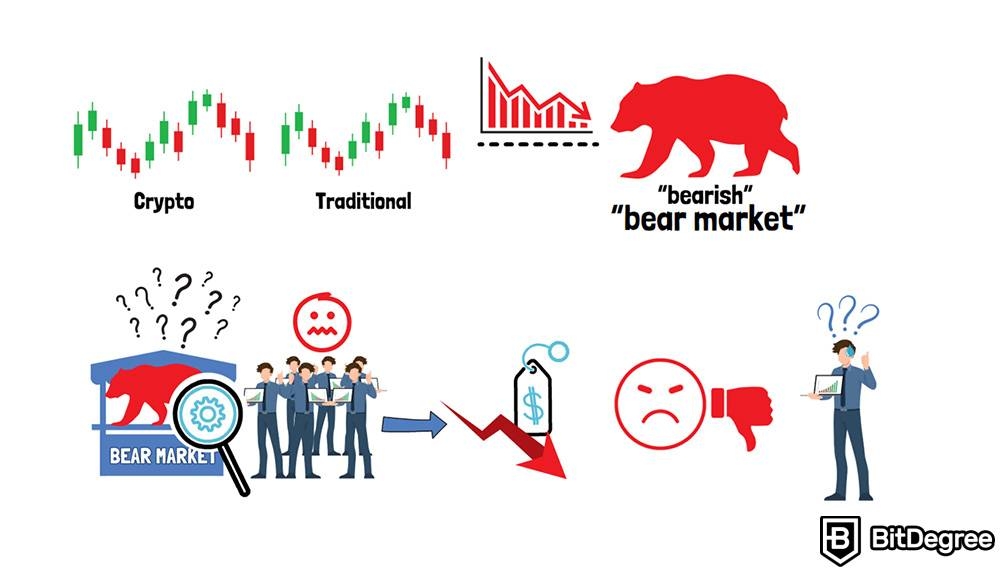
When it comes to crypto, a bear market is when the prices of cryptocurrencies are in continuous decline, new projects struggle to attract investments, and there’s an overall lack of confidence in the whole trading sphere. Or, to put it shortly, it’s when the numbers on charts turn red, and stay that way for way longer than most traders would prefer them to.
Analyzing this from the perspective of bullish and bearish candles, bearish sentiments would be represented by red candles, as well.
Okay, but on the topic of why is it called bullish and bearish, what does this whole thing have to do with bears? Well, as with many things in crypto, the answer is volatile. It depends on who you are going to ask! It’s because there are several explanations about the origins of this term.
Some speculate that it has to do with times when traders would sell bearskins for speculative prices before they even received them from the trappers, thus participating in risky deals. But the most common explanation is that the term “bear market” derives from the way bears, the animals, attack their prey. They do so by swiping their paws downwards. And when everything in the market is going “downwards,” you know you’re in the middle of a bear market.
To illustrate what a bear market looks like in reality, we can take a look at the first months of 2018. It’s the period when the world observed Bitcoin’s price fall from almost $20,000 to below $6,000.
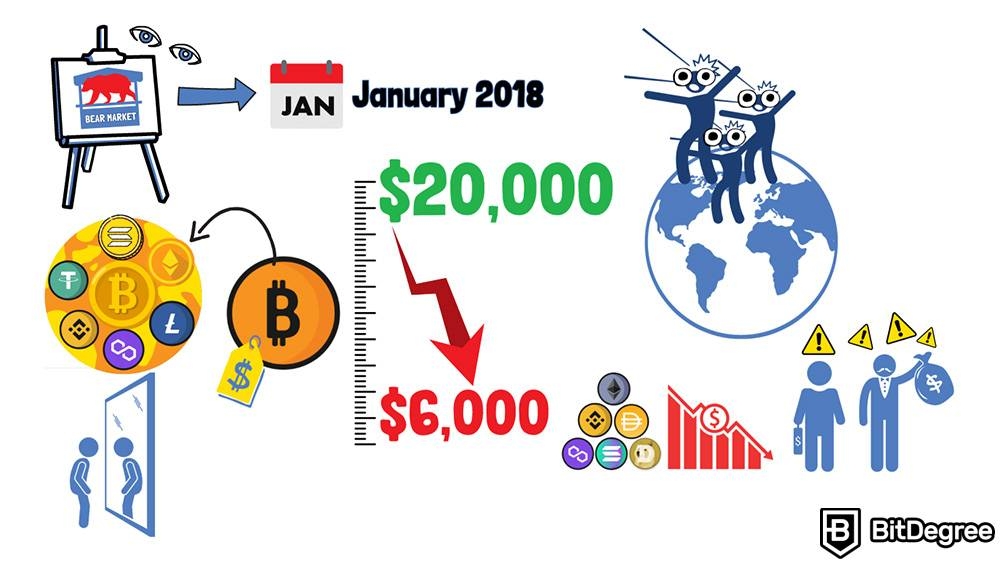
Bitcoin, being the forepost of the crypto world, reflected the overall sentiment of the market, as the majority of less significant altcoins suffered losses as well, and traders chose not to invest into crypto as they did before.
What is a “Bull Market”?
Okay, the next question is what’s the difference between “bearish” and “bullish” patterns?
“Bullish market” or “bull market” refer to the exact opposite of “bear market.” The crypto market is “bullish” when the coin prices increase, the general feeling is joyous and enthusiastic. Investors are optimistic about the future performance of particular projects, products, coins, and the entire crypto market, in general. If the numbers on the charts turn green, and stay that way for an extended period of time, traders know they are in a bull market.
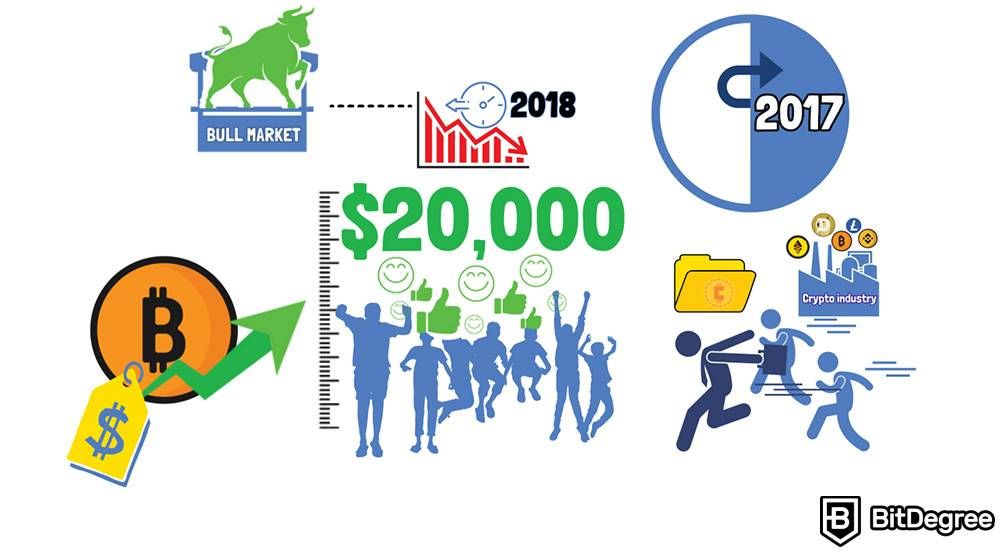
On the topic of why is it called bullish and bearish, just like with the “bear market,” the expressions “bull” and “bullish” come from the way a bull charges. When in attack mode, a bull thrusts its horns up into the air, which poetically resembles the upwards trend of the price increase during a prolonged period of time, be it the price of cryptocurrencies, stocks, securities, or other forms of investment.
And, in regards to bullish and bearish candles, bullish sentiments would be associated with green candlesticks, in the charts.
A good example of a real-life bullish market could be the time before the 2018 bearish market kicked in. It took place in the second half of 2017, and, as mentioned before, it was characterized by the constant rise of Bitcoin’s value.
Eventually, one Bitcoin was worth almost $20,000. The entire industry rejoiced; enthusiasm and optimism were all over the place, as investors were eager to invest in new up-and-coming projects, as well as in the already-established industry giants.
What Signs Tell Us We’re in a Bear Market?
Okay, now you know what is bullish and bearish. However, that was the theory. Let’s get practical. Let’s talk about what signs traders should look for in order to recognize what the current condition of the current market is, and what are the bullish and bearish patterns that traders should be aware of. First of all, let’s discuss what signs give away that a market is going through a bear phase.
As mentioned before, the downwards trend is the essential characteristic of a bearish market. Everything goes down. In other words, you can see a decrease in most of the indicators.
First of all, it’s the decrease in crypto prices. If the majority of the coins continue losing their value, and this doesn’t stop for a long time, it’s clearly an indicator that the market is turning, or already is, bearish.
Another important indicator is the decrease in overall crypto trading volume. Trading volume in crypto refers to the total amount of crypto that’s being traded actively. To put it in simple words, trading volume is a term used to describe all the buying and selling activities that take place during a certain period of time. So, if the trading volume is continuously decreasing, this could very much mean that the bearish market is here.

When the prices and trading volume decrease, it naturally leads to a decrease in overall trading activity. This means that fewer people want to buy or sell their crypto assets. Such characteristics indicate that FUD (fear, uncertainty, and doubt) are taking over the overall market’s sentiment. If you want to know more about how this emotion affects the crypto market, be sure to check the section about FUD!
So, when the prices, trading volume, and trading activity decrease, it all is reflected by a decrease in crypto market capitalization. More commonly referred to as market cap, it’s an index that calculates the size and value of a particular coin, or the entire crypto market, as a whole. Logically, when everything decreases, the market cap goes down, as well.
A decrease measured by different metrics is then accompanied and consolidated by negative media content, such as news, columns, or critical comments. The positive sides and developments get overlooked, while the negative ones gain all the attention. This further strengthens the FUD that’s taking over the market, and everyone can feel the bear’s paws gripping the entire industry.
What Signs Tell Us We’re in a Bull Market?
Moving on, let’s turn to something more positive - a bull market. It’s probably not going to come as a surprise that when it comes down to a bullish market, everything is the exact opposite of a bear market. The main characteristic of a bull market could be summed up in one word: “Increase.”
Increase in cryptocurrency prices, increase in crypto trading volume, increase in trading activity, and in the overall crypto market capitalization. It’s something that’s quite evident when you’re learning about what is bullish and bearish in crypto, especially.
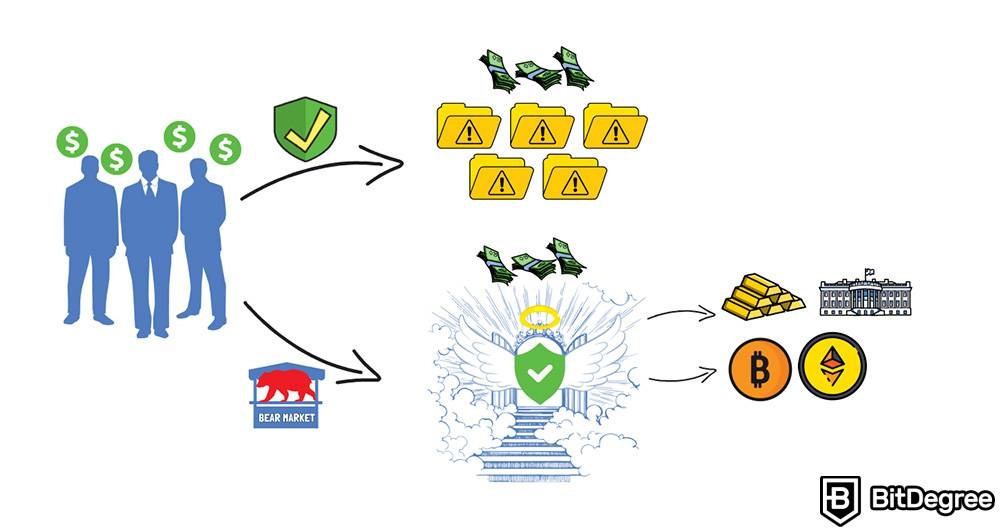
This evokes a feeling of optimism, not only among traders, but investors, as well. If you hear more and more news about various projects receiving funding, this sends a signal that confidence has entered the room. This means that investors feel safe enough to choose riskier projects to invest their money into.
In a bear market, investors usually opt for investing in assets that are considered “safe havens”, such as gold, government bonds, or, in the context of crypto, Bitcoin and Ethereum.
When optimism and confidence enter the market, investors feel like they can take a risk, and go for something less safe, such as a niche altcoin, or a less-known DeFi project. The main thing is that the money is coming into the market, and it further fuels the general optimism, and accelerates the bullish mood.
What Causes a Market to Turn Bullish or Bearish?
Moving further, it’s time to talk about what can suddenly trigger a market to change. In order for the entire market to go through a large change, massively important events have to take place.
Economic data plays a crucial role in how the market is going to look in the near future. For example, inflation rate is something that traders must not ignore. Whenever inflation is on the rise, it signals that the Central banks may begin implementing harsher monetary policies, such as hiking up the interest rates.
An increase in interest rates means that economic activity is about to decrease, and investors and traders may begin hesitating before investing in more-volatile projects or assets.
Another crucial factor could be geopolitical events or natural disasters. A war, a terrorist attack, political instability, and similar events definitely add to the volatility and uncertainty in the crypto market. But sometimes, things happen in an unexpected manner.
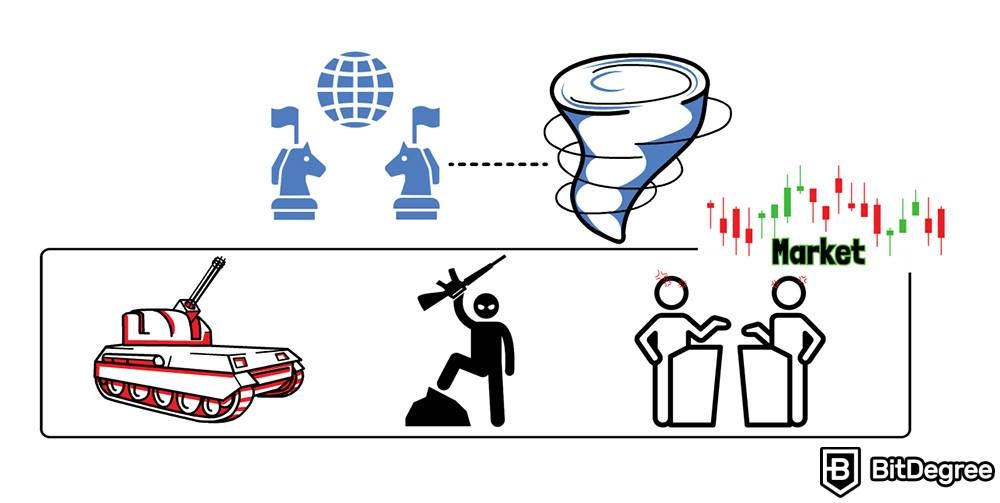
For example, when the war in Ukraine broke out, the market’s reaction was ambiguous. Some investors realized that Bitcoin, unlike local currencies, can be regarded as a safe haven, since it’s not affected by national boundaries. Therefore, despite the growing uncertainty, Bitcoin didn’t take a noticeable hit, and the market didn’t dive into a bearish phase.
Finally, I’ve got to mention the crypto industry itself. Positive updates and news may lead to, or consolidate the bullish sentiment. While negative news, on the other hand, can be detrimental. And if the news comes out from something big and important within the industry, it can cause a domino effect, which could then result in everything turning bearish very quickly.
A recent example could be the collapse of the Terra Luna ecosystem. In 2022, UST and LUNA, two interconnected coins issued by the same company, suddenly malfunctioned. In the course of 2 days, the LUNA coin went from $120 to $0.02, thus triggering a massive sell-off, and a wave of panic amongst investors.
It’s estimated that as a direct result of this event, $60 billion evaporated from the crypto space. It created FUD, and threw the crypto market into its bearish phase that hasn’t yet passed, almost one year after the Terra Luna events.
Wrapping Up
Having said that, it’s time to wrap things up! I hope that, by now, you have learned what is “bullish” and “bearish” when it comes to crypto, what are their key differences, and how important it is for every trader to be able to tell them apart!
The topic is, admittedly, rather expansive - we haven’t even gotten to the technical side of things, such as covering bullish and bearish candles! However, I will not go into more detail about the technical side in this section as there is so much to cover...
Make sure to check out other sections in this Crypto 101 Handbook to find out more about it, and the crypto world, as a whole!










